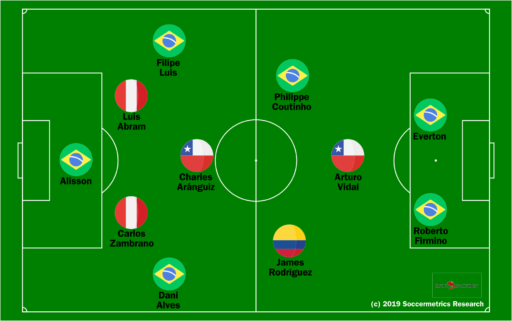Copa América 2019: The Best XI
Categories: Competition Analysis
The 2019 edition of the Copa América is now in the history books, and I’ve written a couple of retrospectives — a tribute to the champions, and a review of the rest of the teams. There’s one final item to take care of, and that is my Best XI of the tournament.
To decide on the best eleven players, I used a combination of basic and advanced metrics as well as my own observations from watching almost every match of the tournament. There were some picks that are very easy, others that are more difficult, and a few that will be controversial. You are more than welcome to tell me in the comments or on Twitter how I got it so very wrong.
I’ve decided to employ a 4-4-2 diamond, so that the midfield contains a holding player, two wingers, and central midfielder.
Goalkeeper: Alisson (Brazil). This was an easy choice, but the goalkeeper choice is also an endorsement of the defensive unit in front. Alisson achieved five clean sheets, allowed just the one goal in the final, and made fewer saves per 90 minutes than any other goalkeeper. He wasn’t called upon often, but he was always present at the call. Arguably the best goalkeeper in the world at the moment.
Left Back: Filipe Luis (Brazil). Tite got a lot out of his wing-backs in this tournament. The man on the right side received a lot of plaudits, and deservedly so, but Filipe Luis combined defensive work with a willingness to move forward and create chances. He made more touches in the left flank of the final third than any other defender, and his 0.48 xA was third-most among left-sided defenders. He committed just four fouls and received one yellow card, a much better disciplinary record than his rivals.
Left Center Back: Luis Abram (Peru). There were several players under consideration for this spot, such as José Giménez, Thiago Silva, and Yerry Mina. All of them created more expected goals than Abram, but Abram was more active defensively (16 tackles, 4 blocks) while committing just four fouls and no yellow or red cards.
Right Center Back: Carlos Zambrano (Peru). Zambrano already had a reputation for being a tough and strong tackler, and he lived up to that image in the Copa América. He stayed in the back and made more tackles than any other player in the tournament. He was involved in the stoppage-time penalty in the final (a dubious penalty at best), but the play must not distract from his good performance.
Right Back: Dani Alves (Brazil). The player of the tournament, according to the organizers, and I can’t disagree. Dani Alves was a constant threat on the right flank, making almost twice as many touches in the right flank final third as any other player and generating more expected goals and assists than any other defender. He put in work in the defensive half as well with 17 tackles, fourth-most among all players.
Holding Midfielder: Charles Aránguiz (Chile). This was a toss-up with Arthur, who achieved almost identical metrics, but in the end I decided to go with Aránguiz. The most central player to Chile’s passing network, Aránguiz distributed the ball superbly and created 2.10 xA as well as one actual assist. He also contributed defensively with 11 tackles and two blocked shots.
Left Winger: Philippe Coutinho (Brazil). The best midfielder in the tournament, and the player with the most xG+xA. His finishing could have been better, but no other player matched his ability to put a dead ball in dangerous locations on the field.
Right Winger: James Rodríguez (Colombia). There wasn’t a bevy of great options on the right side of midfield. Despite a shorter stay in the competition than his team would have liked, James Rodríguez was the fourth-leading midfielder in expected assists. The match against Argentina represented the peak of his performance as he deployed long diagonal balls to devastating effect.
Central Midfielder: Arturo Vidal (Chile). Vidal was the best of the centrally-located midfielders, but he was more of a threat in chances taken than chances created. True to Chile’s reputation of uncompromising midfielders, he was unafraid to mix it up as he made 16 tackles (seventh-most among all players), committed 17 fouls and received three yellow cards.
First Striker: Everton (Brazil). The Golden Boot winner, Everton didn’t create high-percentage scoring chances, but his finishing was clinical and spectacular. All three of his goals were of high quality.
Second Striker: Roberto Firmino (Brazil). The player with the fourth-most xG+xA in the competition, and one of just three players to score a combined four goals and assists. He was just consistently good all tournament.

These Best XI decisions are always difficult. Here are other players who I considered before I made my final decisions. You could view this as an Honorable Mention list.
| Position | Players |
| Goalkeeper | — |
| Defenders | José Giménez, Nicolás Otamendi, Guillermo Maripán, Ángel Trauco, Nicolás Tagliafico, Juan Foyth, Thiago Silva |
| Midfielders | Rodrigo Betancur, Arthur, Casemiro, Luís Advíncula, Wilmar Barrios, Miguel Almirón, Erick Pulgar, Edinson Flores |
| Strikers | Luis Suárez, Eduardo Vargas, Gabriel Jesus, Paolo Guerrero, Sergio Agüero, Alexis Sánchez, Lionel Messi, Edinson Cavani, Jefferson Farfán |
The breakdown of the Best XI by country:
| Country | Number of Players |
| Brazil | 6 |
| Peru | 2 |
| Chile | 2 |
| Colombia | 1 |
And why not — the breakdown by club:
| Club | Number of Players |
| Liverpool | 2 |
| Barcelona | 2 |
| Atlético Madrid | 1 |
| Bayer Leverkusen | 1 |
| Bayern Munich | 1 |
| Basel | 1 |
| Grêmio | 1 |
| Paris Saint-Germain | 1 |
| Vélez Sarsfield | 1 |
This post has been prepared with match event data supplied by DataFactory Latinoamérica.

